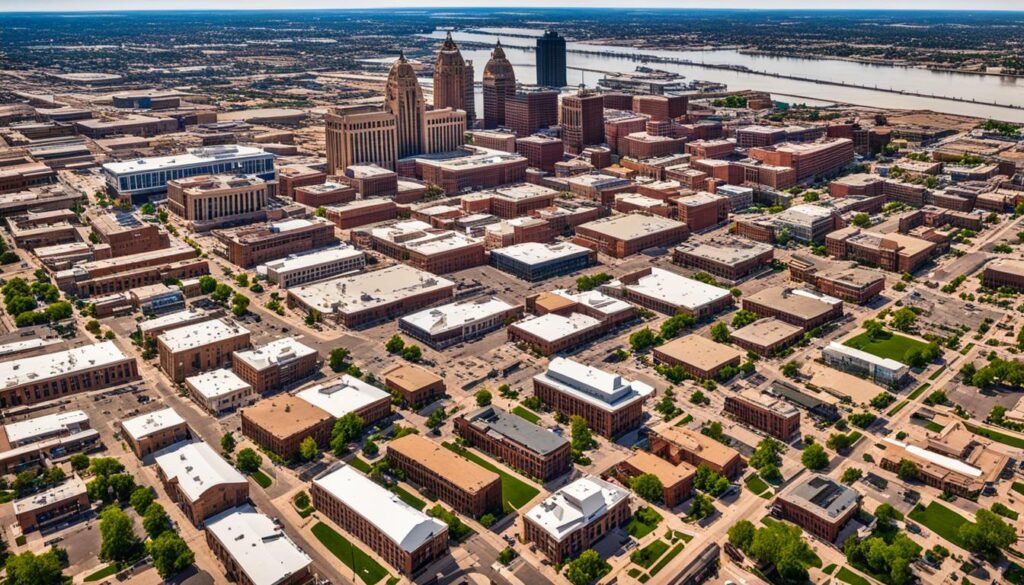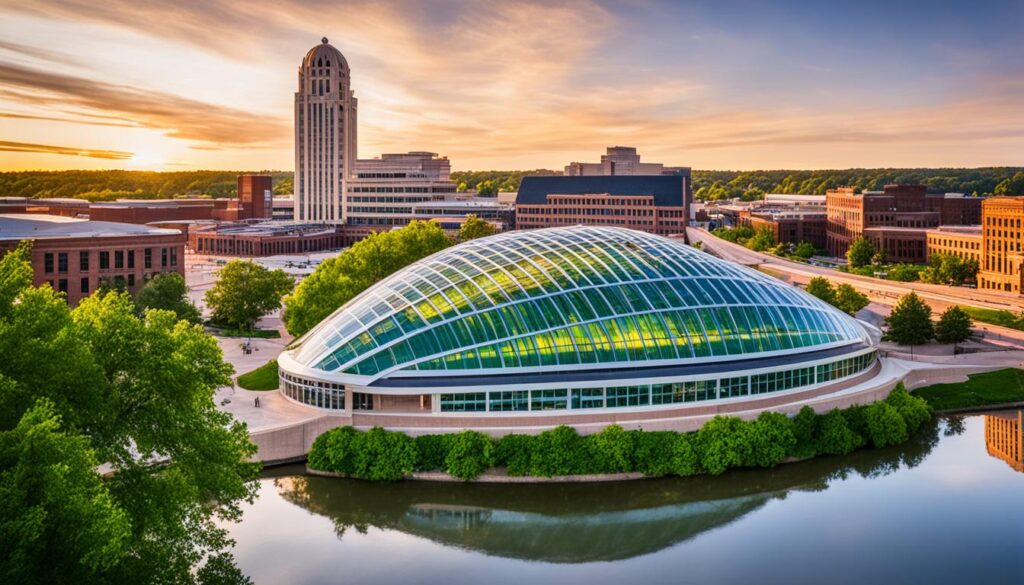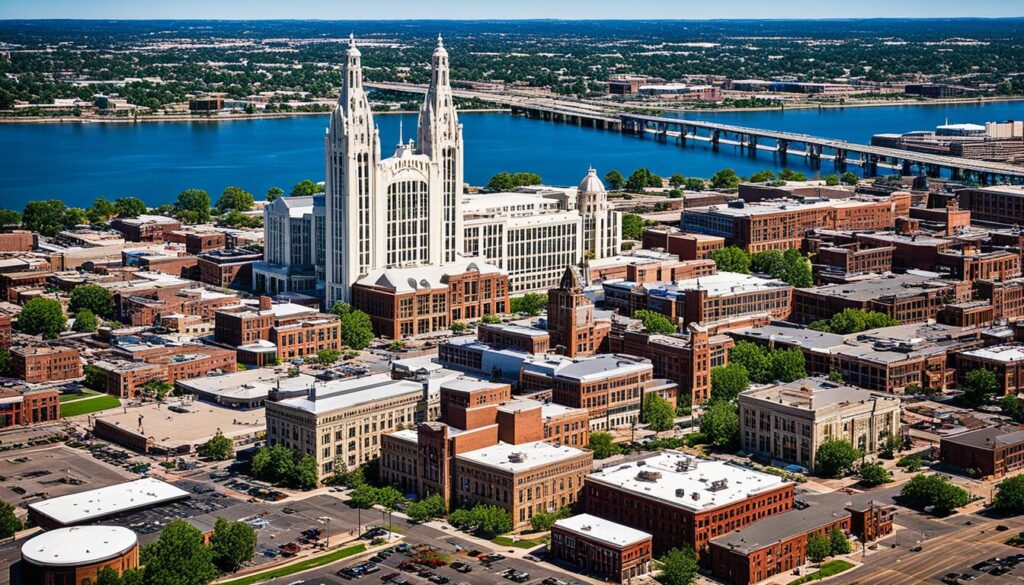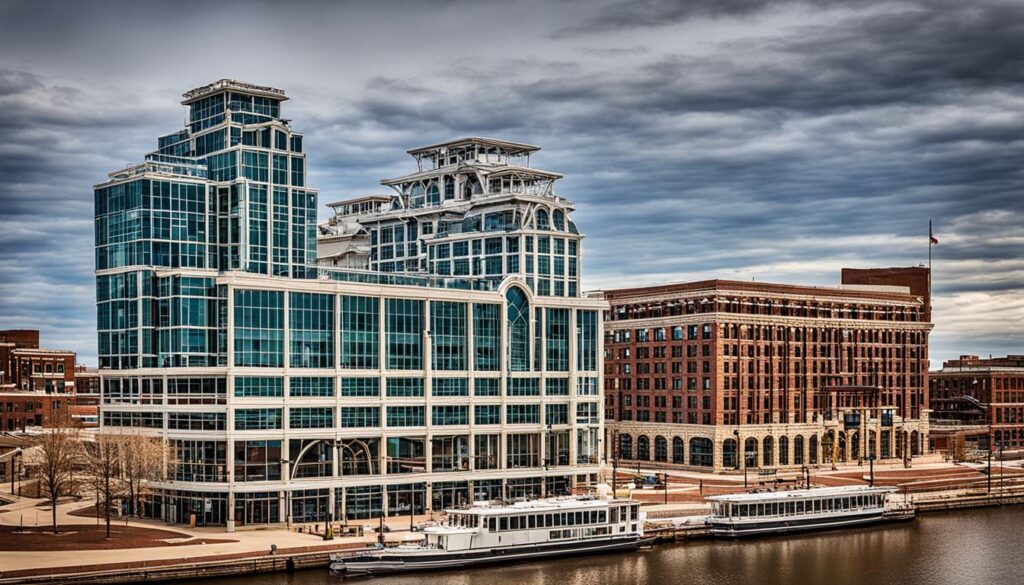Have you ever wondered about the hidden stories behind Peoria’s stunning architecture and historic buildings? From iconic landmarks to lesser-known gems, Peoria, Illinois, is a treasure trove of architectural wonders waiting to be discovered. Embark on a journey through time as we explore the rich architectural heritage and historic landmarks that define this vibrant city.
Peoria’s architectural landscape reflects its fascinating history and growth over the years. Each building has its own unique tale to tell, sharing insights into the city’s past and shaping its character today. Join us as we unravel the architectural tapestry that makes Peoria truly special.
The Historic Importance of Peoria
Peoria, Illinois, holds a special place in history, with its architectural heritage serving as a testament to the city’s progress and evolution over time. The historic buildings scattered across Peoria stand as living records of the past, preserving the stories and memories of earlier eras.
The city’s rich architectural tapestry reflects its diverse cultural influences and economic growth throughout the years. From Gothic Revival structures to Victorian-era gems and modernist designs, Peoria’s architecture is a fascinating blend of styles that showcase the city’s historical importance.
In the heart of Peoria, you will find historic buildings that have witnessed the city’s transformation firsthand. These architectural treasures not only captivate with their distinctive features but also embody the spirit and character of Peoria, Illinois.
“Peoria’s architectural heritage allows us to step back in time and experience the city’s history through its buildings. Each structure tells a unique story, offering insights into the lives of those who have called Peoria home.”
Exploring Peoria’s historic buildings provides a deeper understanding of the city’s roots and its significance in American history. Whether you are a history enthusiast, architecture aficionado, or simply curious about Peoria’s past, these buildings offer a glimpse into the historical fabric of the city.
Landmarks in Peoria
Peoria, Illinois is renowned for its diverse range of landmarks that beautifully showcase the city’s rich architectural heritage and vibrant history. These iconic buildings and structures have become cherished symbols of Peoria’s unique character and are a must-visit for locals and tourists alike.
One of the most famous landmarks in Peoria is the Peoria Courthouse. This stunning architectural gem, built in the Romanesque Revival style, stands tall in downtown Peoria and serves as a testament to the city’s storied past. It is a sight to behold, with its grand facade, intricate detailing, and imposing presence. The Peoria Courthouse is not only an architectural masterpiece but also a significant historical landmark that has played a central role in the city’s legal affairs.
“The Peoria Courthouse stands as a cherished symbol of Peoria’s rich history and architectural prowess. It represents the city’s commitment to preserving its heritage and telling its story through exceptional architecture.”
Another remarkable landmark in Peoria is the Caterpillar World Headquarters. As one of the world’s leading manufacturers of construction and mining equipment, Caterpillar has made a significant impact on Peoria’s growth and development. The Caterpillar World Headquarters, with its modern and innovative design, embodies the spirit of progress and success that defines the city. It stands as a testament to Peoria’s industrial heritage and the company’s strong ties to the community.
Below is a table highlighting some of the notable landmarks in Peoria:
| Landmark | Architectural Style | Year Built |
|---|---|---|
| Peoria Courthouse | Romanesque Revival | 1893 |
| Caterpillar World Headquarters | Modern | 2013 |
| Old Main at Bradley University | Collegiate Gothic | 1897 |
| Pettengill-Morron House | Victorian | 1868 |
| Peoria City Hall | Beaux-Arts | 1899 |
These are just a few examples of the many landmarks that grace the Peoria skyline. Each one offers a unique glimpse into the city’s architectural heritage and serves as a reminder of Peoria’s rich history. Exploring these landmarks is a captivating journey through time, allowing you to appreciate the craftsmanship and artistry that went into creating these magnificent structures.
Continue your exploration of Peoria’s architectural wonders in the upcoming sections as we delve into the different architectural styles that have shaped the city and the efforts made to preserve its historical buildings.
Architectural Styles in Peoria
Peoria is renowned for its diverse range of architectural styles that adorn the city’s skyline. From historic buildings to modern masterpieces, the unique architecture of Peoria showcases the city’s rich heritage and creative spirit.
One of the prominent architectural styles found in Peoria is the Gothic Revival. This style, popular in the 19th century, is characterized by pointed arches, intricate tracery, and ornate detailing. Notable examples of Gothic Revival architecture in Peoria include the beautiful First United Methodist Church and the stunning Peoria Courthouse.
Another prominent style is Victorian architecture, which flourished during the Victorian era in the late 19th century. Victorian buildings in Peoria often feature elaborate ornamentation, colorful facades, and unique architectural elements. One of the iconic Victorian buildings in Peoria is the Pettengill-Morron House, known for its striking Queen Anne-style design.
Peoria’s architectural landscape also reflects the influence of the Modernist movement. Modernist architecture emerged in the 20th century and is characterized by clean lines, simplicity, and the use of new materials. The Caterpillar World Headquarters, designed by the acclaimed architect Helmut Jahn, is a notable example of Modernist architecture in Peoria.
To fully appreciate the architectural diversity of Peoria, one must also explore the works of renowned architects who have left their mark on the city. Architects such as Joseph Lyman Silsbee, Paul Oscar Ehlers, and Roy H. Starts have contributed significantly to the unique architectural fabric of Peoria.
Famous Architects in Peoria:
| Architect | Notable Works |
|---|---|
| Joseph Lyman Silsbee | Peoria City Hall, Murray Building |
| Paul Oscar Ehlers | First United Methodist Church, Charles Ulrich House |
| Roy H. Starts | Peoria County Court House, Scottish Rite Cathedral |
Exploring the architectural styles in Peoria is a journey through time and creativity, offering a glimpse into the city’s past and its commitment to preserving its architectural heritage.
Preserving Peoria’s Historic Buildings
To maintain the unique character of Peoria, preserving its historical buildings is of utmost importance. Efforts by preservation organizations and individuals play a vital role in protecting and restoring Peoria’s architectural gems.
“Historic buildings are not just physical structures; they are the storytellers of our city’s past. They hold memories, embody craftsmanship, and serve as a link to our heritage,” says Sarah Adams, a local historian.
Architectural preservation in Peoria involves a comprehensive approach that includes maintenance, restoration, and adaptive reuse. By ensuring that these buildings are structurally sound and aesthetically preserved, we can continue to appreciate and learn from Peoria’s rich history.
Preservation organizations, such as the Peoria Historical Society and the Architectural Preservation Society, play a crucial role in advocating for the protection of historical buildings. These organizations collaborate with local government agencies and engage the community to raise awareness and garner support for preservation efforts.
Individuals also contribute to architectural preservation by investing in the restoration of historical buildings. Many private owners understand the significance of these structures and their role in maintaining Peoria’s unique identity.
Restoration projects often require intricate craftsmanship to revive the original beauty of the buildings. Skilled artisans and craftsmen work tirelessly to bring these architectural treasures back to their former glory.
Success Story: The Treadway Building
“The restoration of the Treadway Building is a landmark achievement for architectural preservation in Peoria,” says Robert Thompson, a renowned architect.
The Treadway Building, a historic commercial structure dating back to the early 1900s, underwent an extensive restoration process. The project involved meticulous repair of the facade, preservation of the original architectural elements, and modernization of the interior spaces while retaining their historic charm.
| Restoration Highlights | Before | After |
|---|---|---|
| Facade Restoration | ||
| Preservation of Original Interior Details | ||
| Modernized Amenities |
The successful restoration of the Treadway Building stands as a testament to Peoria’s commitment to preserving its historic architecture. It now serves as a vibrant hub for local businesses, adding to the city’s cultural and economic vitality.
Preserving Peoria’s historic buildings ensures that future generations can appreciate and learn from the architectural legacy that defines the city. By safeguarding these treasures, we honor the past while creating a lasting legacy for the future.
The Peoria Riverfront
When it comes to scenic areas in Peoria, the Peoria Riverfront is a must-visit destination. But did you know that it is also home to several historic buildings? As you stroll along the picturesque riverfront, you will encounter architectural treasures that beautifully capture the city’s rich history.
These historic buildings along the riverfront are not only visually stunning but also offer a glimpse into Peoria’s past. Each structure tells a story, reflecting the city’s growth and development over the years. From grand mansions to charming commercial buildings, the architectural diversity is truly captivating.
One of the notable landmarks you will come across is the Murray Building, which dates back to the early 1900s. This historic gem showcases neoclassical architecture and served as Peoria’s first fireproof building.
Explore the Peoria Riverfront and its historic buildings to experience the perfect blend of natural beauty and architectural heritage. Marvel at the intricate details and distinctive styles that have stood the test of time.
Another prominent structure is the former Peoria and Pekin Union Railway Depot, now known as the RiverPlex Recreation and Wellness Center. This historic train station preserves its original charm while offering modern amenities for the community.
Whether you’re interested in architecture or simply appreciate the beauty of historic buildings, a visit to the Peoria Riverfront will not disappoint. Take a leisurely walk, discover the hidden architectural gems, and immerse yourself in the rich history of Peoria.
Explore the Peoria Riverfront’s Historic Buildings:
- The Murray Building – Neoclassical architecture, Peoria’s first fireproof building
- Former Peoria and Pekin Union Railway Depot – Transformed into RiverPlex Recreation and Wellness Center
As you explore the riverfront, take a moment to appreciate the significance of these historic buildings and the role they played in shaping Peoria’s vibrant architectural landscape.
Notable Historical Buildings in Peoria
Peoria is home to a number of notable historical buildings that showcase the city’s rich architectural heritage. Each structure tells a unique story about the past, offering a glimpse into Peoria’s history and cultural significance. From government buildings that have stood for centuries to magnificent churches and iconic theaters, these historical buildings are an integral part of Peoria’s identity.
Let’s explore some of the most remarkable historical buildings in Peoria:
- Peoria City Hall: Built in 1898, Peoria City Hall is a stunning example of Classical Revival architecture. It serves as the seat of municipal government and stands as a symbol of civic pride.
- Murray Baker Bridge: Spanning the Illinois River, the Murray Baker Bridge is an iconic landmark in Peoria. Constructed in 1958, this steel truss bridge is a testament to engineering prowess and connects the east and west banks of the city.
- Peoria Civic Center: The Peoria Civic Center is a multipurpose arena that has hosted numerous events, including concerts, sporting events, and trade shows. Its unique design blends elements of modern architecture with a touch of Brutalism, making it an architectural standout.
- Peoria Players Theatre: Established in 1919, the Peoria Players Theatre is the oldest community theater in Illinois. Housed in a historic building, it has been the stage for countless performances and continues to be a vibrant hub for local theater lovers.
- St. Mary’s Cathedral: St. Mary’s Cathedral is a magnificent Gothic Revival-style church that dates back to the late 19th century. Its soaring spires and intricate stained glass windows make it a must-visit for architectural enthusiasts and those interested in religious history.
These are just a few examples of the many historical buildings that contribute to the charm and character of Peoria. Each structure represents a chapter in the city’s history, reflecting the architectural styles and influences of different eras.
Architectural Highlights of Downtown Peoria
Downtown Peoria is a captivating blend of history and modernity, where stunning architectural wonders line the streets. From elegant classical designs to sleek contemporary structures, the city’s downtown core showcases the best of Peoria’s architectural heritage.
One of the standout buildings in downtown Peoria is the Peoria County Courthouse, an iconic Neoclassical-style structure that dates back to 1899. Its grand façade, featuring Corinthian columns and intricate detailing, is a testament to the city’s rich history.
“Downtown Peoria is a vibrant tapestry of architectural marvels, each telling a unique story of Peoria’s past and present.” – John Watson, Peoria Architecture Enthusiast
Another architectural gem is the Murray Building, renowned for its Art Deco design. This historic skyscraper showcases the exquisite craftsmanship and attention to detail that defined the era.
To explore the best of Peoria’s modern architecture, don’t miss out on the Gateway Building. This striking glass and steel structure, designed by renowned architect Richard Meier, serves as a landmark of contemporary architecture in Peoria.
Influential Architects of Downtown Peoria
Throughout history, visionary architects have left their mark on downtown Peoria, shaping its distinctive skyline. Philip H. Johnson, known for his innovative approach to design, contributed to the city’s architectural legacy with his work on the Peoria Civic Center.
Another influential figure is J. Roy Carver, whose architectural contributions include the Peoria County Jail. Carver’s bold and functional designs have greatly influenced the urban landscape of downtown Peoria.
With its collection of architectural marvels and the creative brilliance of influential architects, downtown Peoria continues to be a source of awe and inspiration.
Hidden Gems: Unique Architecture in Peoria
While Peoria is known for its grand landmarks and historic buildings, the city is also home to hidden gems that showcase unique architectural styles. These lesser-known structures often go unnoticed by the casual observer but hold captivating stories and a rich history.
One such hidden gem is the *Burnham Building*, located in the heart of downtown Peoria. Designed in the Beaux-Arts style by acclaimed architect Daniel Burnham, this architectural masterpiece features intricate detailing and grandeur reminiscent of a bygone era.
Another remarkable example is the *Pettengill-Morron House*, an exquisite Queen Anne style mansion that stands as a testament to the craftsmanship of the era. With its asymmetrical façade, ornate woodwork, and stunning stained glass windows, the Pettengill-Morron House is a true architectural treasure.
For those interested in modernist architecture, the *Schlarman House* is a must-see. Designed by renowned architect Richard Schlarman, this unique residence boasts clean lines, expansive glass walls, and an open floor plan that blends seamlessly with its natural surroundings.
Peoria’s hidden architectural gems demonstrate the diversity and creativity of the city’s design heritage. They provide a glimpse into the lesser-known architectural styles and periods that have influenced Peoria’s built environment.
Peoria’s unique and lesser-known architecture reflects the city’s commitment to preserving its rich history and embracing innovation. Exploring these hidden gems allows you to uncover the stories and architectural wonders that make Peoria truly special.
So, if you’re looking to delve deeper into Peoria’s architectural tapestry, don’t miss the opportunity to discover these hidden gems that often go unnoticed. They offer a unique perspective on the city’s architecture and serve as a reminder of the creativity and craftsmanship that have shaped Peoria’s unique identity.
The Role of Architecture in Peoria’s Identity
Peoria’s architectural heritage plays a crucial role in shaping the city’s identity, making it unique and distinguished. The historic buildings and architectural gems scattered throughout Peoria contribute to the sense of place and offer a glimpse into the city’s rich history.
These iconic structures serve as tangible reminders of Peoria’s past, connecting residents and visitors with the roots and stories that define the city. The architectural diversity found in Peoria reflects its growth and evolution over the years, creating a captivating tapestry of styles and designs.
Whether it’s the Gothic Revival architecture of St. Mary’s Cathedral or the modernist masterpiece of the Peoria Civic Center, each building tells a story and adds depth to Peoria’s cultural fabric.
For residents, Peoria’s architecture provides a sense of pride and belonging. The architectural heritage is a testament to the city’s resilience and the community’s dedication to preserving its history. It serves as a reminder of Peoria’s achievements, struggles, and triumphs, fueling a sense of connection and appreciation.
Visitors, on the other hand, are enchanted by the architectural wonders that Peoria has to offer. The historic buildings and landmarks create a unique atmosphere that sets Peoria apart from other cities. Exploring the city’s various architectural treasures becomes a journey through time, immersing visitors in the past while experiencing the vibrant present.
Peoria’s architectural identity goes beyond aesthetics. It encompasses the stories, values, and aspirations of its people, inviting others to embark on a journey through the city’s history and witness its ongoing transformation. It fosters a sense of community and belonging, inspiring both residents and visitors to appreciate and contribute to Peoria’s architectural legacy.
“Architecture should speak of its time and place, but yearn for timelessness.” – Frank Gehry
To truly understand and appreciate the essence of Peoria, one must embrace its architectural treasures. The historical buildings, landmarks, and unique architectural styles stand as testaments to the city’s vibrant past and reflect its continued growth and development.
Next, we will explore the architectural events and tours that provide opportunities for you to delve deeper into Peoria’s architectural heritage.
Exploring Peoria’s Architectural Events and Tours
Immerse yourself in the world of Peoria architecture by participating in architectural events and tours. It’s an excellent opportunity to discover the city’s architectural treasures and gain a deeper appreciation for its historic buildings.
Peoria offers a range of events and tours that cater to different interests and preferences. Whether you’re a history enthusiast, an architecture lover, or simply curious about the city’s unique charm, there’s something for everyone.
One popular event is the annual Peoria Historical Society’s Architectural Walking Tour. Led by knowledgeable guides, this tour takes you through the streets of Peoria, exploring its iconic landmarks and hidden architectural gems. Learn about the history behind each building and admire the intricate details that make them stand out.
For a more in-depth experience, consider joining the Preservation Peoria Tour. This guided tour focuses on the preservation efforts and architectural significance of Peoria’s historic buildings. You’ll gain insights into the challenges of maintaining these structures and the importance of architectural preservation in Peoria.
If you prefer a self-guided approach, grab a map from the Peoria Visitors Center and embark on your architectural adventure. Visit Peoria’s historic places at your own pace, exploring the unique architecture of each site. Don’t forget to capture memorable photos along the way.
Immerse yourself in Peoria’s vibrant architectural scene by attending local exhibitions and design events. Stay up-to-date with the Peoria Art Guild, which often showcases works by local architects and highlights the city’s architectural accomplishments.
“Exploring Peoria’s architectural events and tours is a fantastic way to deepen your understanding of the city’s rich architectural heritage and its importance in shaping Peoria’s identity.” – Peoria Architecture Magazine
The Top Architectural Events and Tours in Peoria:
| Event/Tour | Description |
|---|---|
| Peoria Historical Society’s Architectural Walking Tour | Guided walking tour exploring Peoria’s iconic landmarks and hidden architectural gems. |
| Preservation Peoria Tour | Guided tour focusing on the preservation efforts and architectural significance of Peoria’s historic buildings. |
| Peoria Visitors Center Self-Guided Tour | Self-guided tour using a map to explore Peoria’s historic places at your own pace. |
Experience the beauty and significance of Peoria’s architectural treasures by participating in these events and tours. Discover the stories behind the buildings and gain a deeper appreciation for Peoria’s architectural heritage.
Conclusion
In conclusion, Peoria’s architecture and historic buildings offer a captivating journey into the city’s rich history and distinctive character. Each landmark and hidden gem adds depth and beauty to the tapestry of Peoria’s architectural heritage, telling stories of the past that still resonate today.
When exploring the city, take the time to appreciate the architectural wonders that surround you. From the iconic landmarks that represent the city’s identity to the lesser-known buildings with unique styles, every structure holds a piece of Peoria’s narrative.
By immersing yourself in Peoria’s architectural heritage, you can gain a profound understanding of its past and present. Discover how architecture has shaped the city’s identity and feel a deep connection to the community’s roots, as you explore the architectural events and tours that allow you to delve deeper into Peoria’s fascinating history.














































